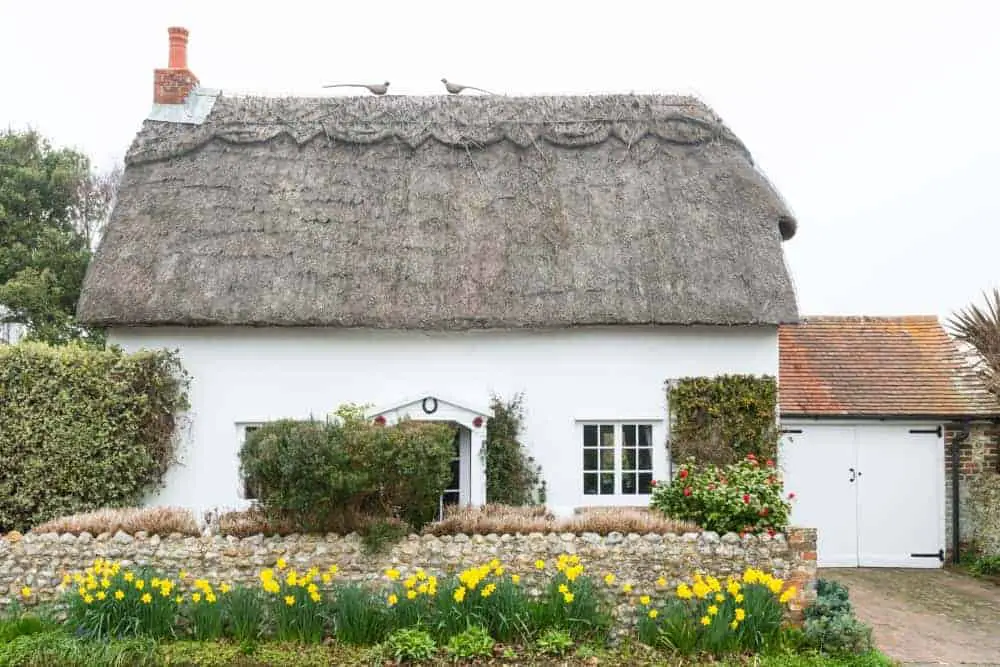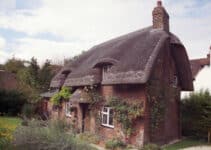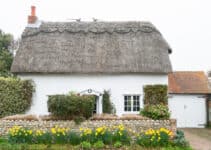Considering many of us are looking for ways to make our homes more sustainable and eco-friendly, it can lead us to ask questions like, are thatched roofs eco-friendly? Thatch is arguably the most sustainable and eco-friendly roofing material. Although they all come from natural materials, it’s the only one that essentially stays in its natural state.
This means it’s biodegradable when it’s done with, and is even harvested in eco-friendly ways.
In this article, we’ll dig into this topic a bit further to understand why thatch is the most eco-friendly roofing material.

Is Thatch Eco-Friendly?
Thatch is about as eco-friendly as you can get for a building material. As you probably know, thatch is made from either water reed or straw.
Both materials are decent carbon sinks. This means they absorb CO2 from the atmosphere as they grow and sequester it in the ground.
Plus, both are fast-growing and harvested annually before being replanted, meaning turnover and carbon sequestration is very high. The benefit of reeds over straw is that the carbon sequestered by the plants is more likely to stay in the ground because it’s wetlands.
However, this is a fairly minor difference.
When you compare this process to other roofing materials, the eco-friendly benefits of thatch become obvious. For example, tiles are made from clay, which is non-renewable and has no carbon sequestration benefits.
The same is true for slate.
So, this is the most obvious eco-friendly benefit of thatch. It’s a renewable resource that absorbs carbon during growth. Plus, harvesting methods are fairly sustainable (or at least they can be), meaning the environmental impact is relatively low.

Is Thatch Biodegradable?
Because thatch is made from natural materials with minimal processing, it’s completely biodegradable. This means it decomposes in a natural environment without any human intervention.
In fact, we can go one step further and say thatch is compostable.
The difference isn’t massive, but a compostable product is one that can be put in a compost heap and leaves less residue behind. You could theoretically put thatch in your home compost heap, and it would break down within a few months.
If it breaks down so quickly, why doesn’t it do this when it’s used to make a roof? The main difference is the presence of moisture – without it, the thatch won’t begin to decompose.
The outer layers of a thatch roof do decompose to an extent, which is why you need to have the roof maintained. Once you introduce air, moisture and microbes, the process happens very quickly.
Are Thatched Roofs Energy Efficient?
Thatched roofs can be very energy efficient compared to other roofing materials. However, it’s still common for thatchers to add extra insulation materials to the roof itself or the attic cavity, depending on the construction.
But what makes thatched roofs so energy efficient?
For this, we’ll look at the thatch specifically rather than discussing the addition of insulation materials. After all, these are fairly standard in terms of their energy efficiency regardless of which roofing material is used.
Thatch’s energy efficiency depends on 3 factors: the roof’s density, its thickness, and the thatch’s condition.
It works as an insulator not because of the material itself, but rather the air it traps in between. Air is a poor conductor of heat, meaning it’s difficult for heat to pass through a thatched roof.
The thicker the thatch roof, the more effectively it’ll prevent heat from passing through.
Density affects energy efficiency because it reduces airflow through the roof. If thatch isn’t densely packed, air can circulate more easily, meaning heat loss is more prevalent.
On the other hand, a densely-packed roof will reduce airflow and heat loss. By extension, wheat straw is better for this because it can be packed more densely than water reed.
To measure thermal energy efficiency, we use a scale called U-values. This refers to how quickly energy passes through 1 metre squared of a barrier.
According to Historic England, thatch has a U-value ranging from 0.23-0.29 at a thickness of 30cm. For comparison, the minimum standard in the Buildings Regulation code is 0.18.
As you can see, thatch is far more energy efficient than the standard expected of roofing in homes. Once you start adding in products like rockwool and thermal barriers, the U-value can shoot up massively.
Final Thoughts
The bottom line is that if you’re looking for the most eco-friendly roofing material, thatch is the way forward.
Add to this the fact that it’s very energy-efficient, and you’ve got an almost perfect product.



